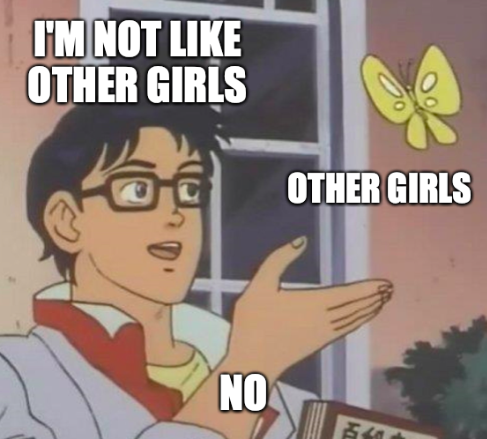Women can also be misogynists.
- Second Class Citizens
- Oct 16, 2020
- 4 min read
We were flying from Taiwan Taoyuan International Airport to Ninoy Aquino International Airport. It was cloudy. The descent thus proved to be turbulent, but I do not know much about airplanes and the systems of flying to comment much about this. One thing I have observed though, is that most people in that airplane commented on how ‘crappy’ the landing is and associated it to the pilot who was a woman. “Babae kasi, kaya pala.” (trans: That’s why, it was a girl!) I just found myself too piqued from hearing all these remarks.
Misogyny is not uncommon. It has been clad in the world across different time periods, across different cultures, across different societies, and even across different genders. Misogyny, which differs from sexism, is an ‘entrenched prejudice against women’. This is typically a case caused when men, who trusted a female figure, had betrayed them or had failed them thus manifesting the trauma in their later lives. Misogyny involves unconscious hate and hostility towards women by practicing what the sexist ideas promote. Misogynists are always sexists, but sexists may not always be misogynists. Hence, misogyny shows different faces and takes different shapes and forms.
Among these, people who blame victims of rape and say “Well, she had it coming” is a clear example of misogyny. It acts out the stereotypes tacked by sexist ideas that women always have the sole responsibility in preventing rape and other sexual assaults. Pinning incompetence and attaching the qualities of being inadequate to how the women do their jobs is utterly definitive of a misogynistic act. The extreme competitiveness with women can also be best exemplified by this occurrence. If a woman does better than a man socially or professionally, the man may feel emasculated and may feel inferior to the woman. Thus, he may look at the situation objectively and fasten the hate on the woman. Allowing men various liberties different to that of his female counterparts is also a misogynist attitude. For some, a woman’s very existence, their fight for equal rights, and their resistance to day-to-day discrimination are perceived as disrespectful. As we see in some cultures now, the female population challenging the current status quo and challenging male dominance were punished either through words or actions, or through outright violence and even death.
The list goes on and on, and many instances can be presented regarding men being misogynists to the other sex. But what is not common, at least with what is manifested in today’s society, is our cognizance to perceive the ways of internalized misogyny by which even the women population practice—deliberately or unconsciously.
Dr. Berit Brogaard, D.M.Sci., Ph.D. in her article “12 Ways to Spot a Female Misogynist” identified four salient stipulations that females can be misogynists too, as manifested by being: (1) The Puritan, (2) The Self-Critic, (3) The Self-Loather, and (4) the She-Devil. Misogynistic Puritans are those that see the “ideal woman” as subservient and submissive to men, especially the husband. While it is perfectly alright to be nurturing and to care for the husband as part of the structure of a family or in some cases the structure of a societal culture, the misogynistic puritan hates women who deviate from the feminine ideal.The Misogynistic Self-Critic purports that men should be dominant alphas while women should be soft and compliant, especially if she want to find “lasting love”. As such, criticizing women who are living their lives not in feminine and traditional ways. It leaves the thinking that women, as betas, cannot act independent on their own and should just rely on what a man can provide for her. Conversely, women who hate women who choose to practice femininity and to hone their feminine qualities can also be suspects in practicing misogyny.
The Misogynistic Self-Loather generates contempt toward one of her own “filthy” kind, including the woman herself. Remarks like “I’m so fat”, “I look so ugly now that I have pimples” are just self-loathing statements that women are all guilty of. The low self-esteem that women constantly stow upon themselves is a characteristic of self-loathing. The hate towards transgender women can also be seen among cis-female populations. Sometimes, we hear statements like “She’s not even a true woman” referring to trans-people. Lastly, a Misogynistic She-Devil sees herself as superior to other women and is in constant competition with other women, which may be displayed outrightly or not. We often hear women say “Oh, I’m not like other girls” especially in matters of wearing makeup, wearing different clothing styles, or even in interests that may not be so representative of the women population.
To sum, minimizing the value of fellow women, mistrusting other women and ourselves as women, as well as believing in gender biases in favor of men are all illustrations of the misogyny that the women population might have internalized.
References:
Sexism and misogyny: what’s the difference? (2012, October 17). The Guardian. https://www.theguardian.com/commentisfree/2012/oct/17/difference-between-sexism-and-misogyny
Prasad, P. (2019, October 1). The Difference Between Sexism and Misogyny, and Why It Matters. The Swaddle. https://theswaddle.com/difference-between-sexism-and-misogyny/
Brogaard, B. (2015, February 18). 12 Ways to Spot a Misogynist. Psychology Today. https://www.psychologytoday.com/us/blog/the-mysteries-love/201502/12-ways-spot-misogynist
Brogaard, B. (2019, August 12). 12 Ways to Spot a Female Misogynist. Psychology Today. https://www.psychologytoday.com/us/blog/the-mysteries-love/201908/12-ways-spot-female-misogynist








Comments